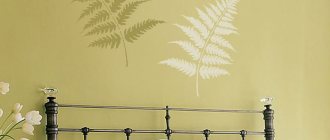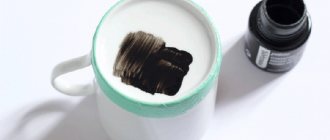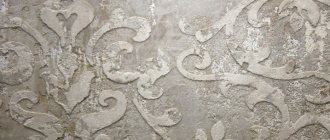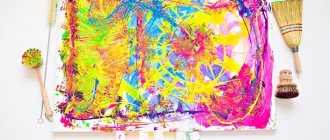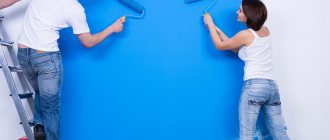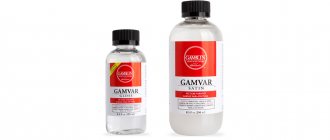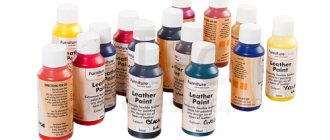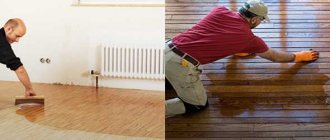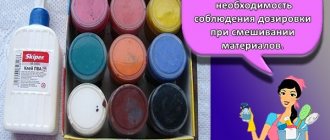Psychologists say that “color therapy” is one of the ways to put your thoughts in order and feel harmony. Add to the “calming” effect that the painting can become an unforgettable gift. Your loved ones will be delighted with it, because you put your soul and time into it. Well, if you decide to keep the painting, there will be one more reason to smile, looking at your own creation, and think what a good idea it was to learn how to paint in oils!
In this article we will tell you:
- What do you need for oil painting?
- How to prepare and prime the canvas?
- "Tricks" of oil painting;
- How to paint peonies with oil?
- How to paint the sea with oil?
- How to paint a landscape in oil?
Do you know the basics of oil painting, but want to improve your skills? Come to art courses in St. Petersburg , where experienced artists will teach you the secrets of painting that are taught only in art schools.
Tatyana Medvedeva and painting teacher with five years of experience Alexey Zhukov shared tips on how to paint in oils .
What do you need for oil painting?
1. Oil paints. For beginners, basic colors will be enough, because they can be mixed to create other shades. Don't forget about white paint - it's the most important!
2. Brushes. They vary in size, shape, material and degree of padding. It is almost impossible to learn how to paint in oils without them.
About the size: large brushes are convenient for painting backgrounds or abstract paintings, and small brushes can be used to draw details: lace or a cat’s whiskers. Therefore, for the first time, stock up on 3 brushes: a large flat (number 12), a medium flat (number 6 or 7) and a small round (number 2 or 3).
About the form: your choice will depend on the style you want to write in. Square flat brushes are good for brush strokes, and round brushes are good for drawing details.
About the material : there are brushes made of bristles and synthetic bristles. Bristles are more expensive, but better quality.
A good brush is your magic wand. It should “sit” comfortably in the hand, retain its shape, but have a plastic structure.
3. A bath for thinner or, as it is called in artist circles, an oil can .
4. Palette. If you think that a wooden palette is disposable, then it is not. Cover it with 3-4 layers of varnish, let it dry and feel free to mix paints on it.
5. Tee thinner . Without it, the oil will be thick and will not adhere to the canvas.
6. White spirit thinner will help clean the palette and brushes.
7. Canvas. Unless you're going for super abstract oil painting or just fine lines, go for a medium-grain linen or cotton canvas. The best option for your first painting is primed cardboard. It's cheap, so you can get your hands on it and not spend money.
8. Cloths for wiping brushes.
Main palette
Each artist selects his own basic palette of shades, which is necessary for his work.
However, it is possible to identify shades without which painting a picture will become difficult:
- Whitewashed. Zinc or lead are used. In the first case, the composition has average covering power and increases the strength of the dye mixture. In the dark, such whites turn yellow, but restore whiteness when exposed to light and can crack. Lead white is distinguished by its viscosity, good hiding power and adhesion. They dry faster than zinc and are toxic. They are resistant to light. White paint with the required characteristics is obtained by mixing different types of white.
- Reds. Among the many shades we can highlight the following:
- “Kraplak” (dark undertone);
- “Red ocher” (restrained shade);
- “Cinnabar” (bright color);
- “Carmine” (pure bright tone);
- “Cadmium Red” (bright shade).
- Green. “Emerald” has a bright transparent shade; restrained shades include “Green Earth”, “Chromium Oxide”.
- Yellow. Yellow ocher has a spectacular golden tone. The shades are restrained, presented in light and dark versions. A bright tone is provided by “Cadmium Yellow”, “Cron” or “Chrome Yellow”. “Strontian Yellow” has a light lemon tint.
- Blue. “Prussian Blue” stands out with its rich, bright shade. “Cobalt Blue” and “Ultramarine” have good characteristics.
- Brown. This color range includes “Umber”, “Burnt Sienna”.
- Black. It is recommended to purchase “Grape Black” or “Burnt Ivory”.
You may need “Cobalt Violet” to work. It is necessary to learn to extract colors by mixing shades, then the basic set will be enough for painting.
How to prepare and prime the canvas?
Preparation for oil painting will take about 3 days. Thus, His Majesty Oil tests your strength! If you can handle it, you can start working. But you can definitely do it!
Step 1: Stretch the canvas onto a stretcher using a staple gun, driving the staples evenly.
Step 2. Prepare gelatin. Mix 20 g of gelatin with 300 g of water. After an hour, when the gelatin swells, heat it in a steam bath, but do not let it boil. Then remove, allow to cool to room temperature and refrigerate for 30 minutes.
Step 3: Gently rub the gelatin into the canvas until it dissolves. Be sure to ensure that the gelatin does not bleed through on the back of the canvas. There should be 5-6 layers of gelatin, with the interval between applications being 12 hours.
Step 4. After 12 hours, apply acrylic primer to the canvas in 2 layers with an interval of 1 hour.
If you think that priming canvas is difficult and beyond your ability, watch the video and you will have no questions left.
If you don't feel like messing around with primer, we have good news! You can buy already primed canvas or cardboard, and even immediately stretched on a stretcher.
The materials are ready, but how to organize the place so that everything you need is at hand? The most convenient way to learn how to paint in oils is to fix the canvas on an easel or sketchbook, and place 2 stools for tools next to it. Don't forget about good lighting, vision is not so easy to restore!
Studio “Discover Yourself” (CAO)
Address: metro station Kurskaya, Podsosensky lane, building 14 building 2, ground floor Website: https://www.otkroisebya.com Phone: +7 985-876-73-36 Cost: from 1600 rub. per lesson
The drawing studio in Moscow “Discover Yourself” invites you to classes in painting and applied arts, which are held in the format of master classes in various areas:
- Oil, acrylic, gouache, watercolor - you will learn to work with different types of paints
- You will also master hard materials - pastel, charcoal, pencil;
- Ebru (water painting), batik (drawing on natural silk), stained glass, monotype, fluid art (liquid acrylic), works from foamiran (plastic suede) - these applied arts have many subtleties, and teachers will be happy to tell you about the specifics of these areas;
- You will learn how to create portraits, be able to calculate a personal mandala, and master drawing miniatures.
- Right-hemisphere drawing training in Moscow reveals your creative potential. After the training, you can draw easily and quickly.
Individual approach, 3 hours of drawing, all materials included in the price!
"Tricks" of oil painting
As soon as you have oil paints and brushes in your hands, set yourself up for a wave of fantasy. There are 2 paths before you. The first is to turn off your head and relax . You can even pour paint onto a canvas and ride a bike on it! And why not, if it gives you pleasure?
The second way to learn to paint in oils in a more complex way is to depict a realistic subject . This is where the rules of perspective, construction, and shadows come in handy.
Rule of depth . Objects in the distance should be smoothed out to make the foreground appear more contrasty and brighter.
Rule of light and shadow. Don't forget that objects don't fly in the air.
The space around an object is always filled, so to prevent it from seeming cut out, add reflections - color highlights from nearby objects.
Light sketch rule. Before starting to work with oil, mark objects transparently with a simple pencil or charcoal so as not to scratch the canvas. But don’t forget to wipe the coal with a cloth, it will smear, but don’t worry, the paint will cover it up.
Of course, oil painting is an activity for those who are prepared. Without an idea of composition and the technique of constructing objects and perspective, it will be difficult to draw a harmonious picture.
But we have great news! You don't have to worry if you put the paint on incorrectly. In oil painting you have an endless number of second chances. Simply wipe the “erroneous” layer with thinner or wait until it dries and apply a new one on top.
Compound
The paint consists of a pigment that gives it the desired color, mixed with drying oil. Even for the production of white compositions, a pigment is used that gives white color or its shade. Pigments also affect the speed of drying and hardening, the durability of the coating, and can reduce the susceptibility of metal surfaces to corrosion.
The pigment is made from finely ground mineral powder. They do not dissolve in oil, water and other solvents, they are quite heavy, so they settle to the bottom - the container with paint must be shaken before use.
Mica, kaolin, and talc are used as additives. Substances are also added to speed up the drying time of the paint.
Compositions based on natural and synthetic solvents are common.
Various forms of modified resins are used as alkyd solvents. The highest quality and most expensive are natural solvents made from quickly drying linseed and hemp oils. Mixed-based paints are also produced.
Oil painting of peonies
We figured out the theory, but without practice it will be forgotten in 3 minutes! I suggest you don’t put it off and embark on a creative flight today. Let's start with something simple and spectacular - peonies.
You can paint flowers however you like: with your fingers, with brushes, a whole bouquet, or one flower on the entire canvas. Start with a light tone in the background, then move on to the flowers, and the last step is to paint the leaves.
If you still don't believe that you can learn how to paint with oils, watch this video! It seems that it won’t be difficult to repeat, what a beauty it turns out!
Marking
The number “2” present in the marking indicates that the composition is suitable for painting all types of surfaces and is made on the basis of drying oil.
Depending on the solvent used, oil compositions are marked as follows.
| Marking | Solvent |
| PF-024 | Pentaphthalic drying oil |
| MA-021 | Natural drying oil based on natural linseed, hemp, and cottonseed oil. |
| GF-023 | Glypthal drying oil |
| MA-025 | Combined drying oil |
Oil painting of the sea
Here I have a question for you: what sea? Water is a changeable element; it can fall in a heavy wave and break against the rocks, shimmering with glare of moonlight, or it can caress the Balinese marble sand and blind your eyes with sparkles of the sun.
Catch 3 life hacks and an example of an oil painting of the sea.
Some people paint, detailing each foam splash, while others paint so abstractly that you only hear the sound of the waves when you move a few steps away from the picture.
But whatever sea falls into your heart, it should be darker at the horizon than in the foreground, and light and shadow will always fall on the wave. The sea is contrasting, it shimmers in many shades and absorbs a range of reflexes.
Learning to paint with oils takes practice. In this video each step will be explained to you, try repeating it and you will feel the sound of the sea you drew.
Art Studio SMART (TsAO, JSC)
Address:
- m. Lomonosovsky Prospekt, Michurinsky Prospekt, 9, building 2
- m. Park Kultury, Sechenovsky lane, 8, building 3
Website: https://studiasmart.ru Phone: +7 (995) 880 48 68 Cost: from 1500 rub.
per lesson Advantages of the studio:
- Affordable prices
- All materials are included in the price
- Classes are suitable for all ages (4+)
- Finished product in one lesson from scratch
- More than 40 areas of courses and master classes
- Even without experience you will create a good job
- Convenient schedule for you
MASTER CLASS “MONOTYPE” Paint a picture on glass and make an impression on paper Master class “Monotype” The oldest method of creating images with a print or print Monotype is a technique for creating an impression by applying…
MASTER CLASS “PASTEL” Master class “Pastel” Create a pastel drawing with your own hands the first time Step-by-step creation of a work with pastels in A3 or A4 format according to the sample You will cope and receive...
Painting a landscape in oil
What do you see in the future masterpiece: endless lavender fields or a village in the Alps? Or maybe Tyutchev’s May thunderstorm? Whatever you choose to paint a landscape, paint in layers. Go over the distant background first in a light tone, then write what is closer, and lastly draw the foreground. Don’t start a picture from one corner, paint everything at once, moving from the general to the details.
To create your first works of art, you only need to stock up on tools and great desire. But if you want to quickly understand the techniques and ways of constructing objects, sign up for art courses. You will see how to prime a canvas, feel the materials and learn how to build a composition according to all the rules.
- The program should include not only different styles of oil painting, but also lessons in composition and subject matter.
- The more the teacher interacts with you, the more knowledge you will take away from the courses. He must correct mistakes, show techniques and, of course, his manner of explaining and drawing must resonate in your soul.
- There should be no more than 10 people in the group , otherwise the teacher simply will not have time to allocate time for everyone.
- Take a look at student reviews , they can clarify a lot.
If you are attracted to a certain technique or are already a “seasoned artist,” pay attention to the master classes. In a few hours you will have both new knowledge and a new painting in your pocket!
The cost of courses starts from 3,000 rubles and reaches 20,000 rubles.
Creativity can be compared to flying on a parachute: the main thing is to take the first step, and you will immediately embark on a flight of fantasy! More practice and self-confidence! Everything will work out!
Tell us in the comments how quickly oil painting came to you. Repost the article so as not to lose tips on how to learn to paint in oils and what you will need for this.
Art studio “Colors of Life” (CAO)
Address: metro station Baumanskaya, Novaya Basmannaya st., 28 Website: https://kraski-zhizni.com Phone: Cost: from 1290 rub. per lesson
Advantages of the creative workshop “Colors of Life” Painting master classes are conducted by experienced teachers who work using their own unique methods that have proven effectiveness. Classes are held in small groups, the teacher has the opportunity to devote enough time to everyone, show, explain, and convey the essence.
For classes, students are provided with:
- Free materials for work - you don’t have to buy anything yourself;
- Practical skills and theoretical knowledge – 90% practice and 10% theory;
- Fragrant coffee and delicious cookies during breaks;
- A guaranteed result, which is expressed not only in the knowledge gained, but also in the drawings created during the lessons;
- A creative atmosphere and a community of like-minded people.
- The potential listener can only choose the painting master class that interests him and a convenient time. If you have any questions, please contact the studio consultants. They will explain everything in detail and help you choose one of the courses.
Geology
Have you noticed how beautiful the cuts of stones are? This is a drawing with a story, a story about changes in climate, relief, and wildlife. You can create your own beautiful specimen of the rock: simply take a vertical canvas and apply horizontal stripes of different widths and different colors to it. Invite the children to draw with you - let them come up with the story of a fictional world in which such a beautiful cut could appear.
Photo: BrennaGiessen / etsy.com
Art studio Anna RA (VAO)
Address: metro station Sokolniki, st. Sokolnichesky Val, 48 Website: https://anna-ra-studio.ru/master-klassi/ Phone: Cost: from 3900 rub. per lesson
Art studio Anna RA invites you to attend entertaining oil painting master classes for adults and children from 3 years old. The level of preparation does not matter, because anyone without drawing experience will be able to paint one gorgeous picture from scratch in three hours under the guidance of our professional teachers.
Studio advantages:
Experienced teachers. Active artists, members of the Moscow Union of Artists and the Union of Artists of Russia
Preparation for admission to art universities in Moscow
Unique master classes. Painting gingerbread with glaze, do-it-yourself postcard, toys using decoupage, decoupage, ebru techniques, painting on glass and ceramics.
Draw your story. During the classes you draw one of the 300 provided paintings of your choice!

